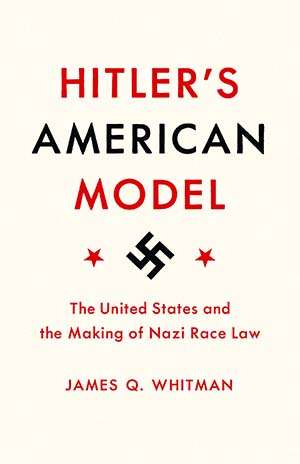What Uncle Sam and Jim Crow Taught Hitler
When Nazi lawyers went looking for racial legislation to emulate, they turned to the United States.

Hitler's American Model: The United States and the Making of Nazi Race Law, by James Q. Whitman, Princeton University Press, 256 pages, $24.95

On June 5, 1934, leading Nazi jurists gathered for a meeting on Germany's "Jewish problem." They had one goal: to draft "unambiguous" legislation banning mixed marriages and sexual relationships. But they were split into two factions: the radicals, who wanted to criminalize miscegenation, and more traditional German jurists, who weren't sure this was workable. During the debates that followed, the radicals in the room repeatedly pointed to an example overseas: the United States of America. Uncle Sam and Jim Crow, they knew, had much to teach them.
In Hitler's American Model, a creepy work of comparative legal analysis, the Yale-based legal scholar James Q. Whitman argues convincingly that American jurisprudence—federal and state alike—provided both inspiration and a model for the most radical Nazi lawyers at the meeting. A little more than a year later, their discussions produced the Nazis' Citizenship and Blood Laws, known collectively as the Nuremberg Laws, which explicitly targeted Jews and separated them from the "true" German people, or volk.
The Law on the Protection of German Blood and German Honor, one piece of that legislation, criminalized sexual relations and marriage between a German and a Jew, defined as anyone with three or four Jewish grandparents. Jews who broke this law were punished with imprisonment or hard labor, sometimes both. Under the Reich Citizenship Law, Jews lost the status of citizen. Soon they were stripped of their political rights, including suffrage, as well. This is where the goose step toward the ovens of Auschwitz began.
Whitman is well aware that his provocative thesis could be dismissed as just another academic blaming the world's evil on America. As he notes, other historians have denied that the United States taught Nazi Germany anything. To these scholars, any favorable mention of the U.S. by the Nazis was a deflection. The German lawyer Andreas Rethmeier even argued that the United States' racist laws and jurisprudence couldn't have been a model for Nazis since America considered Jews white.
Whitman easily refutes them.
In fact, Hitler often applauded the United States for its racist state violence and oppression. In a 1928 speech, he admired how Americans "gunned down the millions of Redskins to a few hundred thousand, and now keep the modest remnant under observation in a cage." In Mein Kampf, he wrote, "The racially pure and still unmixed German has risen to become master of the American continent, and he will remain the master, as long as he does not fall victim to racial pollution."
Several of Hitler's followers sounded similar notes. The Nazi historian Albrecht Wirth believed the founding of the United States was the most important development of the last millennium up until World War I, writing in 1934 that "the struggle of the Aryans for world domination received…its strong prop" with America's birth.
More importantly, Hitler knew about the racism—both de facto and de jure—in American immigration, citizenship, and miscegenation law. "The American Union…simply excludes the immigration of certain races," he wrote in Mein Kampf. "In these respects America already pays obeisance, at least in tentative first steps, to the characteristic völkisch conception of the state." November 1933's National Socialist Monthly praised America's "draconian immigration law" and stated that "to these circles of tribally related Americans we reach out our hand in friendship."
Nazi lawyers also noted with approval that Anglo-Saxon America had reduced whole groups of people to second-class citizenship. The Democratic Party in the South had pioneered ways to keep black people in particular from voting. Voter suppression tactics included literacy tests, property requirements, voting roll purges, felon disenfranchisement, and poll taxes. Because of its "racist election law" and its one-party stranglehold over the South, Nazi lawyer Heinrich Krieger even wondered whether the Democratic Party would, like the Nazis, make "the Party an organ of the State."
Whitman doesn't argue the Nazis cut and pasted U.S. immigration and citizenship laws into their own legal code. The influence was more subtle. United States law, according to Whitman, served "as welcome evidence that 'race consciousness' had already begun to shape the law in a leading 'Nordic' polity" and that "the winds of history were blowing in their direction."
With the Blood Law, however, the influence was more direct. At that June 1934 meeting that led eventually to the Nuremberg Laws, the participants repeatedly discussed the America's racist legal codes, with the Nazi radicals in attendance the most enthusiastic in their approval of the American example. During the meeting, Justice Minister Franz Gurtner showed off a memo cataloging American race laws. "Almost all American states have race legislation," he said, according to a transcript of the meeting.
What most excited the radicals was that certain states criminalized miscegenation, which is exactly what the Nazis would do a year later. The more traditional lawyers at the meeting were skeptical of the idea, arguing that criminalizing such behavior would be impossible—judges had too much discretion to determine who was and wasn't Jewish. German law until then, notes Whitman, had been based on "clear and unambiguous concepts." The traditionalists wanted that feature to be preserved. Otherwise, the rule of law would become the rule of men.
The radicals replied that U.S. law allowed judges to determine who was or wasn't "colored" even though race couldn't be scientifically determined. Roland Freisler, who would later become president of the Nazi People's Court, stated that the American model would "suit us perfectly." If the U.S. could institute explicitly racist legislation, then so could Nazi Germany. "What the American example showed," writes Whitman, "was that German judges could persecute Jews even without legislation founded in clear and scientifically satisfactory definitions."
Whitman's most terrifying observation may be that some of the radicals thought America's obsession with protecting its whiteness went too far. One Nazi writer bemoaned "the unforgiving hardness" of the idea that "an American man or woman who has even a drop of Negro blood in their veins" was considered black. Even the Nazi Blood Law limited its targets to people with at least three Jewish grandparents. Then again, there were Nazi hardliners who pushed for a more expansive classification in which just one Jewish grandparent defined you as a Jew.
In his conclusion, Whitman reminds readers of the dangers of a politicized legal culture. He argues that both the United States and Nazi Germany embraced legal realism, the idea that the law should evolve with the times, as opposed to legal formalism, where the law constrains the designs of ambitious legislators. Under legal realism, Germany fell victim to the totalitarian state of Hitler's Nazism, while the United States moved toward a Faustian bargain between the New Dealers and Southern segregationists. "The same 'realistic' legal philosophy that could be invoked to defend the 'bold [economic] experiments' of [Franklin Delano Roosevelt] could also be invoked to defend the racism of the Southern Democratic Party," Whitman notes.
"When the politics is bad," he writes ominously, "the law can be very bad indeed."
This article originally appeared in print under the headline "What Uncle Sam and Jim Crow Taught Hitler."


Show Comments (55)